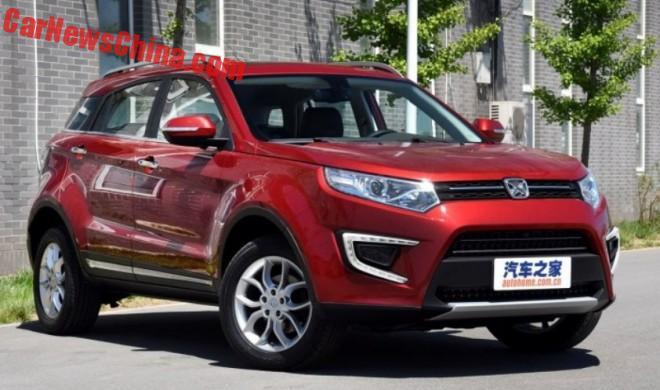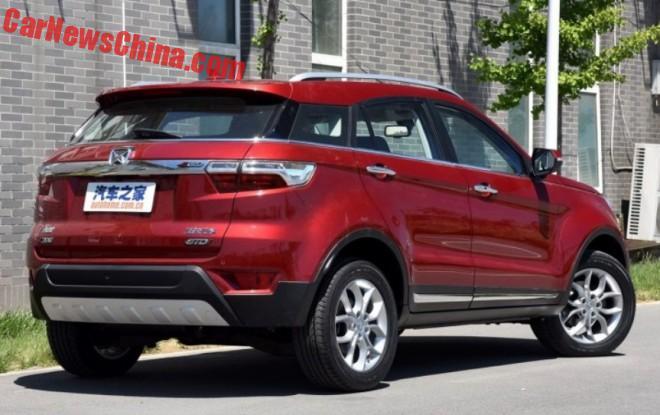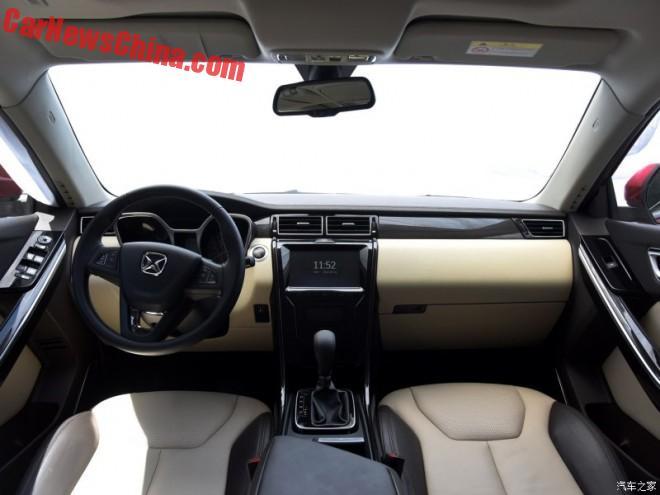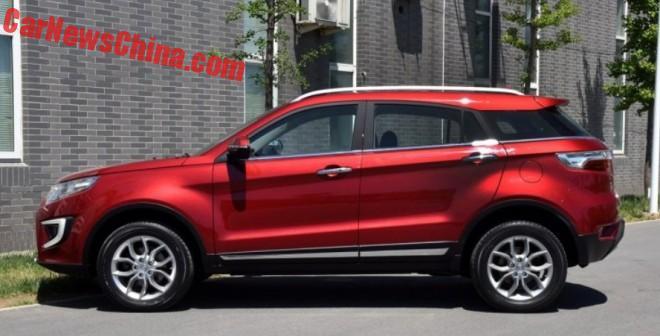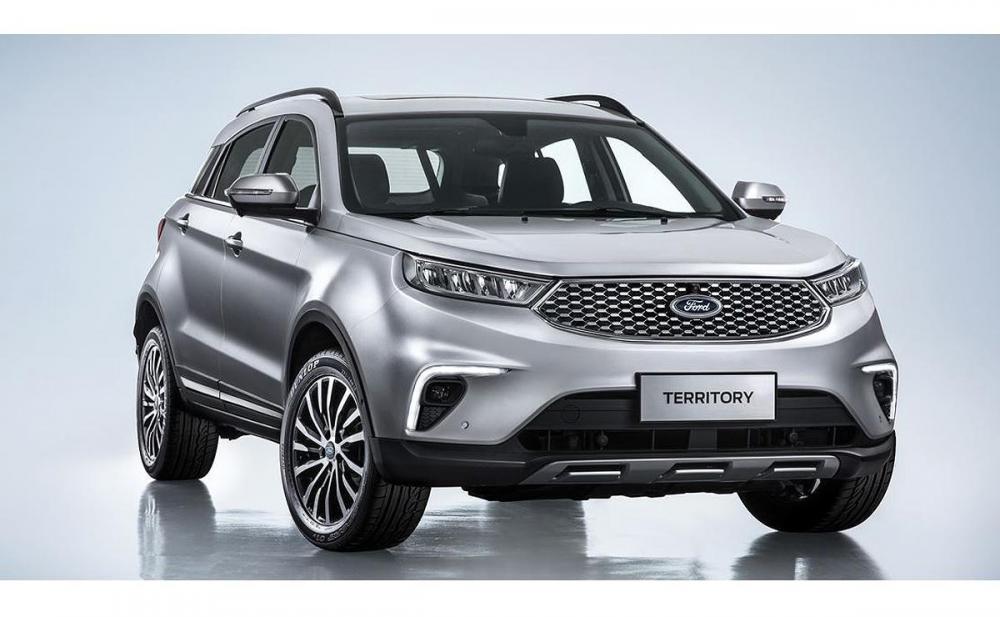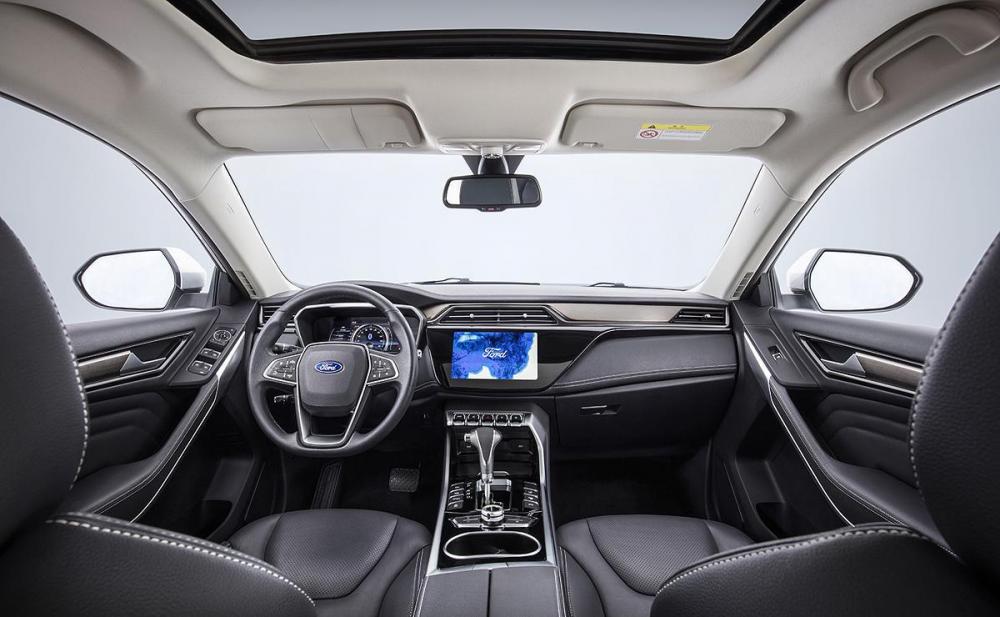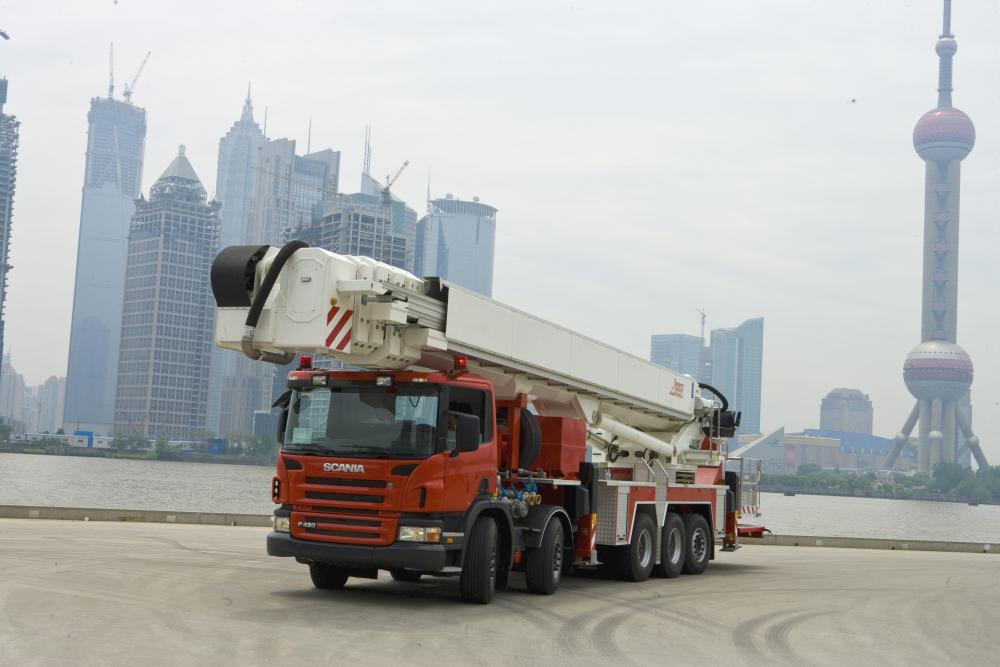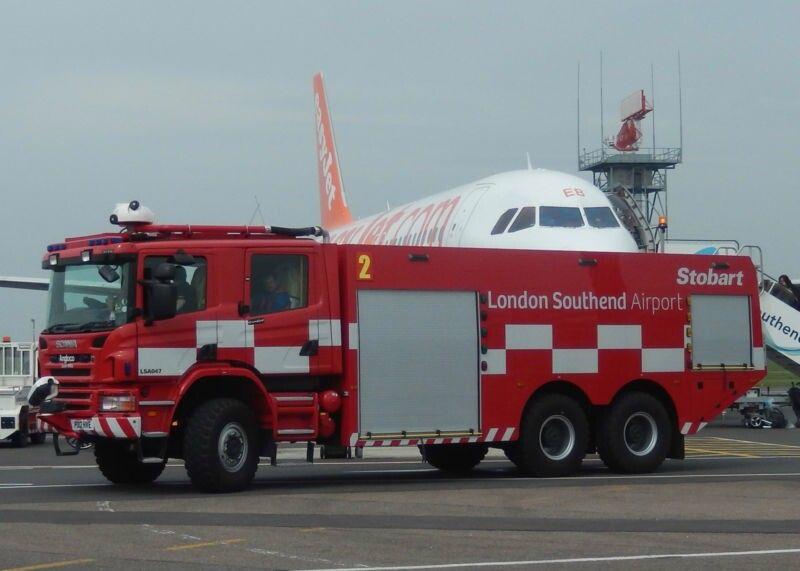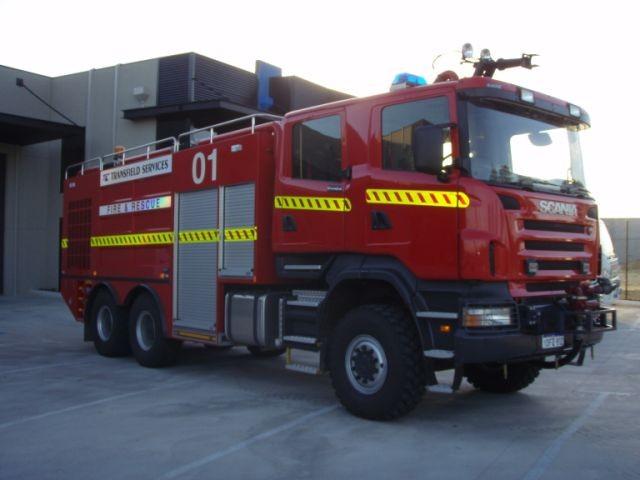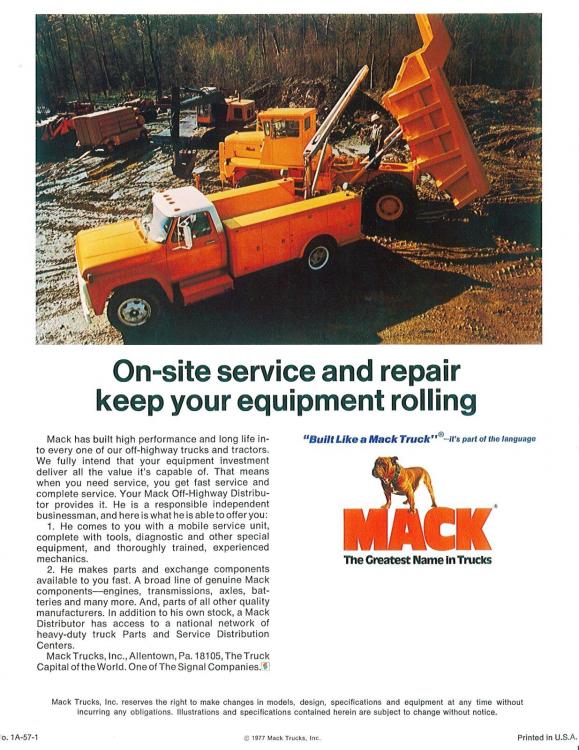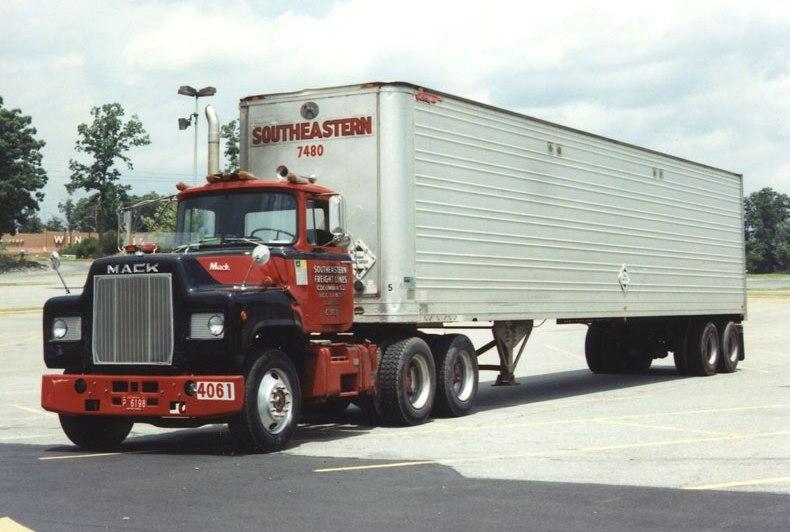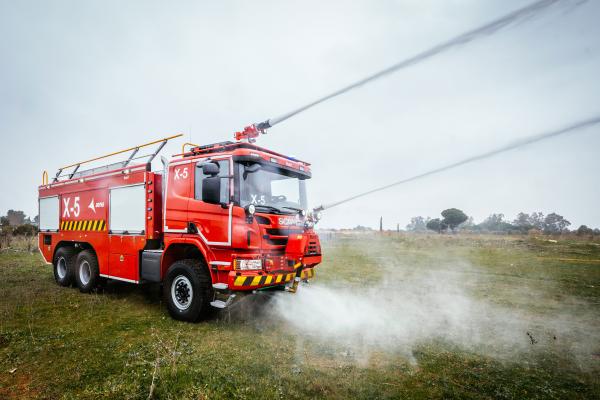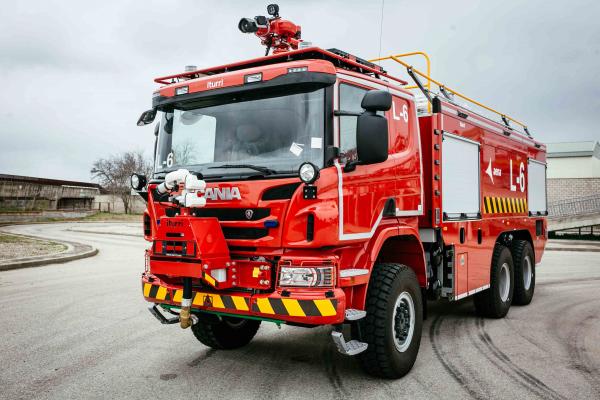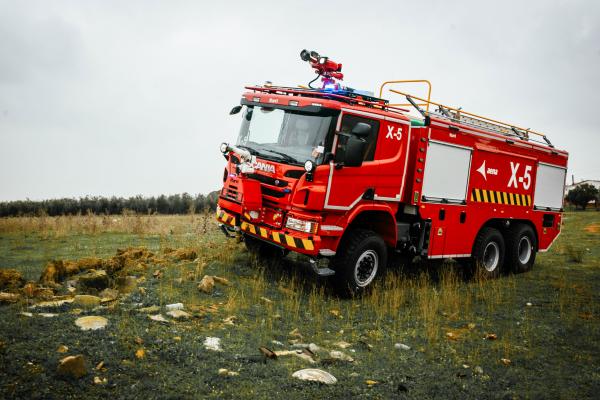
kscarbel2
Moderator-
Posts
18,550 -
Joined
-
Days Won
112
Content Type
Profiles
Forums
Gallery
Events
Blogs
BMT Wiki
Collections
Store
Everything posted by kscarbel2
-
Desperate Times: New Ford Territory SUV For China Is Just A Rebadged JMC Car News China / August 8, 2018 So what do we have here? This is an SUV called the Ford Territory. Ford says it is new, especially developed for China and all. That is not totally true. It is a new Ford, but not a new car. The Territory is based on the Yusheng S330, a cheap local SUV that sells for just 80.000 yuan or $7300. Yusheng is a brand under Jiangling Motors Corporation (JMC), one of Ford’s two joint venture partners in China. This joint venture will also make the Territory. Morphing the S330 into the Territory was easy: slap a new front on, change the dash a bit, fancy wheels, Ford badges, and done! Why does Ford do this? Because they are desperate. Ford sales in China are slow and not growing. The company doesn’t have anything good in the pipeline. But hey, guess what? Their joint venture partner had just the kind of sweet compact SUV that it needed. So Ford grabbed it by the grille. Ford has not announced anything on engines yet, but we bet the Territory will use the same engine as the S330: a 1.5 turbo with 163 hp. We will have a good look at the ‘new’ Ford on the Chengdu Auto Show in September. Ford also states that the Territory is aimed at China’s second and third tier cities. Good idea. But the Yusheng S300 is aimed at exactly the same target area. I am very curious what is next. JMC has more nice SUVs in their lineup, including some electric stuff that Ford also doesn’t have. And of course JMC owns the Landwind brand. What about a Ford based on this? The world upside down. In the past, Chinese joint venture partners were begging their western partners for old platforms to base some of their own cars on. Nowadays, the western partners crave for the Chinese platforms. Also see Volkswagen with their weird SOL EX20. And Finally: this Ford Territory should not be confused with the Australian Ford with the same name. These Territories have nothing in common. .
-
This new product is unrelated to the Ford Falcon-based Territory (on the EA169 platform) that was sold in Australia over the 2004-2016 period. Beautiful vehicle, and just $22,000.
-
Ford introduces its first 48-volt vehicle.....in China, with Cargo/Transit partner Jiangling Michael Martinez, Automotive News / August 8, 2018 Ford Motor Co. hopes a new midsize crossover in China will help it stem mounting losses* in the world's largest vehicle market. The automaker early next year will introduce the Territory, which it bills as an affordable [150,000 Yuan/US$21,990.27] utility that slots between the EcoSport and Kuga. It was developed with its joint-venture partner, Jiangling Motors Corp. The vehicle comes with either a gasoline engine, a 48-volt mild hybrid system or a plug-in hybrid powertrain. Available technology includes an infotainment system with Mandarin voice-command and the automaker's Co-Pilot360 suite of standard driver-assist features. "It's a very unique product for China," Jim Farley, Ford's president of global markets, told Automotive News. Ford is targeting entry-level customers outside of China's biggest cities. It says midsize utility sales in that country grew 38 percent from 2012 to 2016. "Territory is a key proof point for how we will grow in China," Ford China CEO Peter Fleet said in a statement. "We brought Territory to market with speed, high quality and cost efficiency. It will be affordable for young families and new buyers across China, not just the coastal mega-cities. And the technology will delight customers." Ford is preparing a product blitz for China as sales and profits continue to fall there. It plans to launch more than 50 new vehicles there by 2025. The automaker said its sales in China fell 25 percent in the first half of 2018. Its China operations lost $483 million in the second quarter before taxes, versus a $23 million profit there a year earlier. "It's going to take us a while to get out of that issue," CFO Bob Shanks said last month. Farley last month said Ford had "serious shortfalls" in its go-to-market strategy in China and that dealer profitability had been hurt by improper maintenance of the product portfolio. He said Ford has begun to address dealer profitability in the region and that, by the end of next year, 60 percent of its products there will be new or updated. * (CNBC, August 8, 2018) Ford's business in China has been faltering since last year. Its vehicle sales tumbled 25 percent in the first half of 2018 from the same period a year ago to 400,443 vehicles, which led to a second-quarter pre-tax loss of $483 million for its China operations. According to consultancy LMC Automotive, it was Fords biggest first-half percentage decline in sales volume since starting operations in China in 2001. .
-
Ford unveils new Transit skeletal chassis cab
kscarbel2 replied to kscarbel2's topic in Trucking News
It's hard to believe the F-550 has been out since 1999. Seems like yesterday. I do remember the new-for-1987 Class 4 F-Super Duties. We all thought that was something, and long overdue (renamed F-450 in 1999). The F-350s had been overloaded for years. -
Nikola raises $100 million this month Truck News / August 7, 2018 PHOENIX. Arizona – Nikola Motor Company announced today that it anticipates the $200 million C round will be oversubscribed with more than $100 million already raised and funded this month. The company has a $1.1 billion pre-money valuation. “Nikola’s business model has been vetted, and the investment world is taking notice. So far this year we have kicked-off plans to build the largest hydrogen network in the world with NEL, secured a massive 800-truck order commitment from Anheuser-Busch, developed the most energy dense battery system on the market with almost 400 watt hours per liter, engineered a 240 kW fuel cell, kicked-off electric vehicle stability controls and electric ABS with Wabco, designed a thermo-management and HVAC system with Mahle, finalized the most advanced class-8 independent suspension on the market with Meritor, relocated our company to Arizona to build our new 150,000 sq. ft. headquarters and now closed on $100,000,000,” said CEO Trevor Milton. “To say we have come a long way in 2018 is an understatement,” added Nikola CFO Kim Brady. “Now imagine Nikola in 2019. Who wouldn’t want to be part of this company’s story?” Milton also added that the company will soon announce a 2019 event in Phoenix, where customers, suppliers, media and industry insiders will be able to see all the latest Nikola products in action. Nikola Motor Company is pioneering hydrogen-electric renewable technology. The zero-emission trucks — which will be able to travel between 500 and 1,200 miles and be refilled within 20 minutes —will be part of fleets beginning in 2020 and in full production by 2021. To date, the company has nearly $11 billion in pre-order reservations. By 2028, Nikola is planning on having more than 700 hydrogen stations across the U.S. and Canada. The first 14 stations will be up and running by 2021.
-
-
Scania crew cab fire apparatus are very popular. https://www.bigmacktrucks.com/topic/51895-tailored-for-emergency/ .
-
Ford unveils new Transit skeletal chassis cab
kscarbel2 replied to kscarbel2's topic in Trucking News
-
I always liked the Brockway instrument panel in our R/U/DM cab more than our own, as it offered a larger surface area, more flexibility.
-
Ford F-150 Supercrew investigated after complaints of fires linked to seat belts Reuters / August 7, 2018 The nation's top traffic safety regulator is investigating complaints of fire during crashes in some Ford Motor Co. F-150 Supercrew pickups that have been linked to a seat belt component. NHTSA said there were five complaints alleging fires following the activation of seat-belt pretensioners made by ZF TRW or Takata Corp. during a crash involving the vehicles. Pretensioners tighten up any slack in the seat belt webbing in the event of a crash and work in tandem with air bags. While there were no injuries or fatalities, three of the vehicles were completely destroyed by the fire, NHTSA said. An estimated 1.4 million vehicles made between 2015 and 2018 could be affected in the investigation, the agency said.
-
Ford offers dealers $1,000 bonuses to fix recalled Rangers Michael Martinez, Automotive News / August 7, 2018 Ford Motor Co. is offering its U.S. dealers $1,000 for every 2006 Ranger covered by a “do not drive” warning that they find and fix, a company spokeswoman said Tuesday. The affected vehicles were built with potentially defective Takata Corp. airbag inflators. Ford in February expanded the "do not drive" warning to include 36,330 of the pickups, although the number was later revised to 33,320. Ford spokeswoman Elizabeth Weigandt said the automaker has accounted for or repaired about 75 percent of the recalled Rangers and decided to take "additional, unprecedented measures" by offering dealers incentives to find the remaining trucks. Ford told retailers they can earn $1,000 for each Ranger they locate and repair. "We want to get to these vehicles as quickly as we can," she told Automotive News. "We just don’t want our customers driving these vehicles at all." The affected Rangers were built from August through December 2005 at Ford's now-shuttered Twin Cities Assembly Plant in St. Paul, Minn. The defective inflators can explode with excessive force, unleashing metal shrapnel inside vehicles. The problem led to the largest automotive recall in history and forced Takata to file for bankruptcy protection in June 2017.
-
OEM R model turbo boost gauge?
kscarbel2 replied to seyser's topic in Antique and Classic Mack Trucks General Discussion
Did you ask Watt's Mack about availability? (1-888-304-6225) -
Saudis threaten Canada with 9/11-style attack https://www.rt.com/news/435237-saudi-threaten-canada-terrorism/
-
The Dubai Road Express | Legends of Long Haulage
kscarbel2 replied to kscarbel2's topic in Trucking News
-
Air Products took delivery of 6V92-powered R-models (R626STs) in the 1980s via the Allentown Branch. You had to wonder............
-
Ford unveils new Transit skeletal chassis cab
kscarbel2 replied to kscarbel2's topic in Trucking News
I hear you, but I feel Ford is behind the curve. Look at Ranger. Why did they ever discontinue US sales? Why didn't Ford immediately replace the outgoing model with the new 2012 global market T6 Ranger? What a no-brainer. Why did they walk away from Bronco, a signature Ford product unlike anything the competition sells. Why are 3.0 diesel-powered F-150 XL and XLT pickups only sold to fleet customer number holders.....individuals are not permitted to buy one? (Why send a customer away with money in hand?) Why did Ford get out of heavy trucks after spending US$500 million? Why did Ford waste everyone's time introducing the LCF with a cramped Mazda cab the US market would never accept, and that Navistar 4.5 litre V6 full of teething problems. The idea of a US market Ford low cab forward was perfect, but the execution was shockingly poor. Incompetence rears its ugly head again and again at Ford US (meanwhile at Bill Ford-backed Ford-Otosan, they are methodically getting Ford back on the global stage in a way not scene since Ford US hands destroyed the development of the Transcontinental!) Saw a new Avon F-650 U-Haul today. But knowing U-Haul, I'll bet money that Ford makes minimal profit from those sales. They're giving them away for the visibility. It used to take us 5 years to create an all-new Mack. Today, it probably takes Ford 3 years to design an all-new F-Series. Any which way, when a new F-Series launches, they are already at work on the next.....they're always in the pipeline. -
The Guardian / August 5, 2018 Hamza bin Laden, the son of the late al-Qaida leader, has married the daughter of Mohammed Atta, the lead hijacker in the 9/11 terror attacks. Osama bin Laden’s half-brothers, Ahmad and Hassan al-Attas, said they believed Hamza had taken a senior position within al-Qaida and was aiming to avenge the death of his father, shot dead during a US military raid in Pakistan seven years ago. Hamza bin Laden is the son of one of Osama bin Laden’s three surviving wives, Khairiah Sabar, who was living with her husband in a compound in Abbottabad, near a large Pakistani military base, when he was killed. He has since made public statements urging followers to wage war on Washington, London, Paris and Tel Aviv and is seen as a deputy to the terrorist group’s current leader, Ayman al-Zawahiri. “We have heard he has married the daughter of Mohammed Atta,” said Ahmad al-Attas. “We’re not sure where he is, but it could be Afghanistan.” Western intelligence agencies have been increasingly focusing on the whereabouts of Hamza bin Laden over the past two years, seeing him as more likely than anyone else to galvanise followers. His marriage to the daughter of Atta, an Egyptian national, appears to confirm that the 9/11 alumni remains a central hub of al-Qaida and that the organisation itself continues to be organised around Osama bin Laden’s legacy. Another of Bin Laden’s sons, Khalid, was killed in the US raid in Abbottabad. A third, Saad, was killed in a drone strike in Afghanistan in 2009. Letters purportedly written by Osama bin Laden and seized from the compound suggested he was grooming Hamza to replace him, partly to avenge the death of Saad. Bin Laden’s wives and surviving children have returned to Saudi Arabia, where they were given refuge by the former crown prince Mohammed bin Nayef. The women and children remain in close contact with Bin Laden’s mother, Alia Ghanem, who told the Guardian in an interview that she remained in regular touch with surviving family members. “When we thought everyone was over this, next thing I knew was Hamza saying I am going to avenge my father,” said Hassan al-Attas. “I don’t want to go through that again. “If Hamza was in front of me now, I would tell him: God guide you. Think twice about what you are doing. Don’t retake the steps of your father. You are entering really negative and horrible parts of your soul.” The family claimed they did not have any contact with Osama bin Laden from 1999 until his death in 2011. They said they had not heard from Hamza bin Laden. In recognition of his apparent status within al-Qaida, the US government labelled him a specially designated global terrorist in January 2017, meaning his assets could be blocked and anyone who dealt with him faced arrest.
-
Ford unveils new Transit skeletal chassis cab
kscarbel2 replied to kscarbel2's topic in Trucking News
I hear you. There are many questionable drivers with CDLs (though I'm not an advocate for autonomous trucks). All I'm saying, is with a CDL, the driver has undergone some formal training, whereas the non-CDL driver has not. Of course it depends where you are, but I observe that GM lost massive market share when it walked away from commercial. Yes, they still offered a 3500HD cab & chassis, but fleets ignored that thin offering. I believe Dodge grabbed most of GM's market share.....everywhere I look is a new 4500 and 5500. And I believe Dodge has been incrementally grabbing Ford market share.....still a lot of fleets that never regained their confidence in Ford after the never-ending diesel issues, and then Ecoboost nightmares. They looked at Dodge, with the Cummins, as a known entity, a safe bet. Dodge has witnessed premature DEF pump failures on the 3.0L Ecodiesel (Italian VM Motori) engines (a US market emissions design/sourcing issue), but the ISB-powered HDs appear to be winning more and more market share from Ford defectors. The new hood-tilting 2019 Chevrolet (why not GMC?) Silverado HD finally offers the engine access we always knew was possible but the US automakers didn't want to create (to keep architecture standardized with the smaller pickups). But away from the commercial market for what seems like an eternity, with dealers who don't have experienced "commercial" people, GM has an uphill battle ahead of it. Most fleets simply aren't going to jump back on board the GM train....they're going to need some convincing in the form of generous incentives. The Isuzu Duramax V8/Allison combination certainly works satisfactorily, though a straight 6 (e.g. Cummins ISB) would/does deliver better fuel economy. Frankly, if I was GM, I would use the superb 5.2-litre 215 horsepower (520 lb.-ft.) Isuzu 4HK1-TC in the 3500HD thru 6500HD range instead of the Duramax V8 for class-leading fuel economy to spur sales, or at least offer it as the base engine. Why ignore the opportunity to brag as having the most fuel efficient offering? -
From the workers point of view and my own, a straight run is/was more convenient. But sometimes production planning has orders contrary to logic.
-
http://www.dailymail.co.uk/news/article-6025457/Australian-discovery-World-War-Two-SOLVE-mystery-missing-pilot-Amelia-Earhart.html
-
Probably Jim. All the U-700s I supported had NH power. Holly Farms taught me with their 903-powered K100s (on "the shore" in Temperanceville, VA) that the 903 didn't make for a good truck engine. They finally replaced them with beautiful new Ford HN80s.
-
All the Macks I knew with Cherryville (northwest of Gastonia), North Carolina-based Carolina Freight were Mack-powered. They bought some of everything, and ran many White 4000s (local) and 7000s (over-the-road). Winston Salem, North Carolina-based McLean Trucking also ran many makes, including Whites. There was so much trucking going on in North Carolina at one time, we had a factory branch in WInston Salem, in addition to Charlotte, to support the massive fleets up there. We sold the Winston-Salem branch to Jim Bland and Triad Mack was born.
-
Bob, the cabs on the Cummins-powered U-700s were indeed mounted higher for clearance and a larger radiator. When I recall the U-700, I instinctively think of Columbia, South Carolina-based Southeastern Freight Lines. They had NHs, not 903s. .
-
Ford unveils new Transit skeletal chassis cab
kscarbel2 replied to kscarbel2's topic in Trucking News
I think you'll find that what works in Europe, the global market, can work here. Towing needs to be regulated. A CDL-less 16-year-old kid barreling down a crowded 45mph road doing 55mph in an (insufficiently tow rated) E-250 or F-250 pulling a cheap and overloaded tandem-axle trailer overloaded with a skid loader, breaker and numerous other items that he failed to secure properly (aka. projectiles) is all too common place. These accidents-waiting-to-happen are seen daily coast-to-coast. Such towing should be limited to private property (at your own risk), and banned from public roads. In the 550 range, I'd like to see a (Cargo) low-cab-forward. With that you get the needed weight distribution, with the added benefit of enhanced visibility. -
Scania Group Press Release / August 3, 2018 Spanish airports giant adds 14 new firefighting trucks to its emergency fleet. AENA, the Spanish airports authority, has made a significant reinforcement to its firefighting and emergency capabilities with the addition of 14 Scania P 490 6×6 fire trucks. Each of the vehicles is equipped with a 13-litre Scania engine, and nine of the trucks have superstructures built by Iturri, while five have been built by Rosenbauer. Ideally equipped for all airport emergencies According to Eurostat, Spain had the third-largest volume of airport traffic in 2017 (after the UK and Germany), with almost 250 million passengers. And for AENA, which counts 46 airports and two heliports in its national network, the Scania P 490 6×6 is ideally equipped for fighting fires and dealing with other airport emergencies safely and quickly. The new firefighting truck measures up to the stringent specifications that are required by the International Civil Aviation Organisation (ICAO). Crucially, the vehicle has rapid speed of response. When fully loaded it can accelerate from 0 to 80 km per hour in less than 35 seconds, and it has a maximum speed of 100 km per hour. The firefighting capability is also impressive. It includes a 6,100-litre water tank, a foam tank with a storage capacity of 750 litres and a chemical dust deposit of 225 kilos. The truck also has a water cannon mounted on the ceiling of the cabin that can provide a variable jet for spraying water and foam, at a distance of more than 65 metres. A secondary front cannon under the windscreen has a range of 40 metres. .
BigMackTrucks.com
BigMackTrucks.com is a support forum for antique, classic and modern Mack Trucks! The forum is owned and maintained by Watt's Truck Center, Inc. an independent, full service Mack dealer. The forums are not affiliated with Mack Trucks, Inc.
Our Vendors and Advertisers
Thank you for your support!


